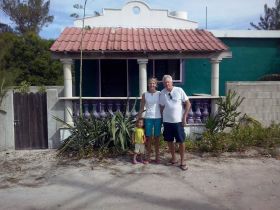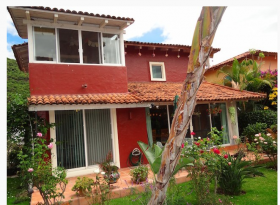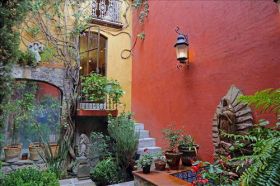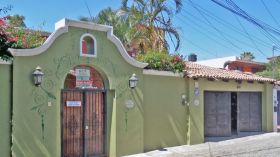What are the home mortgages like in Mexico? How long are home mortgage terms and how much down payment is required?
Carmella Peters Romero - Peters & Romero
 The term of a home mortgage in Mexico varies anywhere between 10 to 20 years. Usually, you would need to put a down payment of at least 20%. From the perspective of an American, the interest rate for mortgages here in Mexico is quite high, starting at 8%.
The term of a home mortgage in Mexico varies anywhere between 10 to 20 years. Usually, you would need to put a down payment of at least 20%. From the perspective of an American, the interest rate for mortgages here in Mexico is quite high, starting at 8%. A foreigner can get a mortgage in Mexico. You have to show that you have a steady income or that you have the ability to pay by showing sufficient assets. Getting a loan from a bank can be a lengthy...
 The term of a home mortgage in Mexico varies anywhere between 10 to 20 years. Usually, you would need to put a down payment of at least 20%. From the perspective of an American, the interest rate for mortgages here in Mexico is quite high, starting at 8%.
The term of a home mortgage in Mexico varies anywhere between 10 to 20 years. Usually, you would need to put a down payment of at least 20%. From the perspective of an American, the interest rate for mortgages here in Mexico is quite high, starting at 8%. A foreigner can get a mortgage in Mexico. You have to show that you have a steady income or that you have the ability to pay by showing sufficient assets. Getting a loan from a bank can be a lengthy process because the banks are so meticulous, so it is advisable to use the services of a mortgage broker.
While the practice of purchasing a property using a mortgage to cover a significant portion of the cost is very familiar to many Canadians and Americans, Mexicans tend to use their own resources to cover most if not all of the purchase price.
(Penthouse in Polanco, D.F., Mexico City, Mexico, pictured.)
Posted November 11, 2015
Ivan Castillo - Secure Title Riviera Maya
 Mortgages in Mexico would be very similar to the ones in the US. However, the main differences are the interest rates. For example, currently there isn’t any single bank that will provide financing to foreigners, while in the past, there were multiple banks that were providing financing to American, Canadian, Spanish, and British residents and the citizens. These banks included Lehman Brothers, GMAC, Wachovia, and another small bank out of Texas that’s called International...
Mortgages in Mexico would be very similar to the ones in the US. However, the main differences are the interest rates. For example, currently there isn’t any single bank that will provide financing to foreigners, while in the past, there were multiple banks that were providing financing to American, Canadian, Spanish, and British residents and the citizens. These banks included Lehman Brothers, GMAC, Wachovia, and another small bank out of Texas that’s called International... Mortgages in Mexico would be very similar to the ones in the US. However, the main differences are the interest rates. For example, currently there isn’t any single bank that will provide financing to foreigners, while in the past, there were multiple banks that were providing financing to American, Canadian, Spanish, and British residents and the citizens. These banks included Lehman Brothers, GMAC, Wachovia, and another small bank out of Texas that’s called International Bank. However, because of the real estate and financial crisis back in 2008 all those banks decided that they did not want any additional risk and they shut down their bilateral lending programs.
Mortgages in Mexico would be very similar to the ones in the US. However, the main differences are the interest rates. For example, currently there isn’t any single bank that will provide financing to foreigners, while in the past, there were multiple banks that were providing financing to American, Canadian, Spanish, and British residents and the citizens. These banks included Lehman Brothers, GMAC, Wachovia, and another small bank out of Texas that’s called International Bank. However, because of the real estate and financial crisis back in 2008 all those banks decided that they did not want any additional risk and they shut down their bilateral lending programs.For Mexicans, the lending institution will appraise the value of the property you’re going to be using as collateral. The mortgage rates would be about 11% to 13% annually and the terms typically will be 10 years, 15 years, or 30 years.
(Beach on the Riviera Maya, Yucatan Peninsula, Mexico, pictured.)
Posted January 24, 2016
Alfonso Galindo - I Go Yucatan
 Any legal resident of Mexico has options for financing or refinancing a home mortgage.
Any legal resident of Mexico has options for financing or refinancing a home mortgage. Terms vary by institution, but usually require a minimum down payment 20% to 30% and most have a age limits on those who can qualify, generally set at 65 years old.
 Any legal resident of Mexico has options for financing or refinancing a home mortgage.
Any legal resident of Mexico has options for financing or refinancing a home mortgage. Terms vary by institution, but usually require a minimum down payment 20% to 30% and most have a age limits on those who can qualify, generally set at 65 years old.
Posted January 25, 2016
David Schwendeman - Mexlend
Unfortunately, there’s a lot of myth and misunderstanding about mortgage availability in Mexico. This is largely due to the many changes which have occurred within the lending industry over the past few years along with some outdated information still circulating online. Just to set the record straight, since about 2005, there have been and still exist mortgage options available. The rates and terms have changed considerably, though, as have the...
Unfortunately, there’s a lot of myth and misunderstanding about mortgage availability in Mexico. This is largely due to the many changes which have occurred within the lending industry over the past few years along with some outdated information still circulating online. Just to set the record straight, since about 2005, there have been and still exist mortgage options available. The rates and terms have changed considerably, though, as have the providers. Also, the terms are different for Mexican Nationals, United States and Canadian Nationals and other Foreign Nationals. Generally speaking, the most attractive programs are available to Mexican Nationals and those Foreigners who have already or are willing to take steps to establish themselves within Mexico. For those unwilling or unable to make a permanent or semi-permanent commitment within Mexico there are still options, but they are at the higher end of the interest rate spectrum. Here are the programs available today and basic guidelines for qualification:
1. Peso Loans through the Major Mexican Banks.
Minimum Down Payment: 10% to 20% (Can be less with INFONAVIT Credits)
Interest Rates - Initial Purchase: 8.5% to 12%
Interest Rates Cash Outs and Refi: 10.5% to 16%
Here's the catch: you must be a MX National living and working in Mexico OR you must have your Residency Card AND either income derived in Mexico OR a MX Bank Account with at least 3 to 6 months of *seasoned deposits (the longer the better) in an amount roughly 2.5X the proposed monthly mortgage. Also, you need to establish 2 open lines of credit in Mexico with a total available credit limit of $50K Pesos. If you do not have these three things already - it can take 6 to 12 months before you would be seasoned well enough to submit a file to the bank and then another 2 months to close; basically about a year to a year and a half in total before you would be able to close on a property.
*Seasoned deposits represent a history of regular, monthly deposits from a consistent source which can be demonstrated as income.
2. Private Money Mortgages through US Hedge Funds.
When the US Banks (GE Money, IMI, Compass, etc) pulled out of the Mexican market by 2012 we established two Private Mortgage Funds. These loan programs are lo doc and easy to qualify for. They use income, residency and credit history from your home country. You must put at least 35% down and can usually close in 3 to 4 weeks.
Here's the catch: Interest Rates are between 14% and 16%.
3. The “Tu Opcion” program.
The "Tu Opcion" program is specifically designed for Mexican Nationals or dual Nationals who reside AND earn an income in the US or Canada but wish to purchase property in Mexico. Down payment requirements are typically 10% to 20% for a 20 year mortgage with interest rates at about 10.5%.
***No Prepayment Penalty on either loan genre
***Interest Paid in Mexico is tax deductible in the US, Canada and elsewhere
***Many buyers use Option 2 above as an “in” to the property and once closed, immediately begin to lay the groundwork to refinance at better rates and terms through Option 1.
Posted February 3, 2016
Mark O'Neill
 Purchasing property in Mexico is more on a cash basis versus how we take out loans in order to finance the purchase of property in the US. Here in Mexico, the preferred method is that the buyer presents cash on the deal as opposed to arranging financing. I was told from the realtor in Ajijic that having a mortgage is not really an option for me and that probably 90% of all sales are on a cash basis.
Purchasing property in Mexico is more on a cash basis versus how we take out loans in order to finance the purchase of property in the US. Here in Mexico, the preferred method is that the buyer presents cash on the deal as opposed to arranging financing. I was told from the realtor in Ajijic that having a mortgage is not really an option for me and that probably 90% of all sales are on a cash basis. My particular decision was to come up with...
 Purchasing property in Mexico is more on a cash basis versus how we take out loans in order to finance the purchase of property in the US. Here in Mexico, the preferred method is that the buyer presents cash on the deal as opposed to arranging financing. I was told from the realtor in Ajijic that having a mortgage is not really an option for me and that probably 90% of all sales are on a cash basis.
Purchasing property in Mexico is more on a cash basis versus how we take out loans in order to finance the purchase of property in the US. Here in Mexico, the preferred method is that the buyer presents cash on the deal as opposed to arranging financing. I was told from the realtor in Ajijic that having a mortgage is not really an option for me and that probably 90% of all sales are on a cash basis. My particular decision was to come up with approximately two-thirds of the cash for the deal and I had a note with the owner of the property on the last third of the purchase. The owner of the property that I purchased is a Canadian investor who actually lives in a beautiful home in the village of Ajijic but he owns numerous properties in the area that he either rents out or refurbishes, as he did with mine. What we had was an individual deal and you can get different kinds of deals depending on the seller.
(View of Hacienda O'Neill from the backyard, Ajijic, Mexico, pictured.)
Posted June 25, 2016
Chris Gruenwald - Biencom Real Estate
 Mexico is a cash market. Home mortgages here are difficult to obtain at this time if you are an expat unless you have a Mexican income, are running a Mexican company, or are being employed by a Mexican company or a company that is active in Mexico.
Mexico is a cash market. Home mortgages here are difficult to obtain at this time if you are an expat unless you have a Mexican income, are running a Mexican company, or are being employed by a Mexican company or a company that is active in Mexico. If you are looking to get a mortgage here at Lakeside Chapala, you can try to find a direct financing with one of the homeowners but those usually require at least 60% down payment and have a tem of less than 5...
 Mexico is a cash market. Home mortgages here are difficult to obtain at this time if you are an expat unless you have a Mexican income, are running a Mexican company, or are being employed by a Mexican company or a company that is active in Mexico.
Mexico is a cash market. Home mortgages here are difficult to obtain at this time if you are an expat unless you have a Mexican income, are running a Mexican company, or are being employed by a Mexican company or a company that is active in Mexico. If you are looking to get a mortgage here at Lakeside Chapala, you can try to find a direct financing with one of the homeowners but those usually require at least 60% down payment and have a tem of less than 5 years
There are some North American expat lenders that will lend to other expats but just like with homeowner financing, they usually like to see you put down at least 60% down payment and they can cover for you anywhere from 6 months to 5 years. About 90% of the transactions that I do with expats are cash transactions. Mexicans have a lot more financing options available to them here in Mexico so with Mexicans, it is probably about 60% cash.
(Home being sold for $130,000 USD, Lake Chapala, Mexico, pictured.)
Posted September 23, 2016
Alicia Gomez - Collins Real Estate
.jpg) If you are one of my clients and you tell me that you want a specific house but have no money for it, I will recommend that you get a mortgage. I have friends that offer mortgages at a low interest so I will give you the options.
If you are one of my clients and you tell me that you want a specific house but have no money for it, I will recommend that you get a mortgage. I have friends that offer mortgages at a low interest so I will give you the options. Another option is for me to talk to the seller of the house and tell them my client doesn’t have money to pay cash and then I’ll try to strike a deal to get an installment payment with interest. We could have the deal that they...
.jpg) If you are one of my clients and you tell me that you want a specific house but have no money for it, I will recommend that you get a mortgage. I have friends that offer mortgages at a low interest so I will give you the options.
If you are one of my clients and you tell me that you want a specific house but have no money for it, I will recommend that you get a mortgage. I have friends that offer mortgages at a low interest so I will give you the options. Another option is for me to talk to the seller of the house and tell them my client doesn’t have money to pay cash and then I’ll try to strike a deal to get an installment payment with interest. We could have the deal that they keep the domain, meaning the house is still theirs until it is fully paid. It’s similar to getting a mortgage but there are no mortgage companies in Chapala and Ajijic where I live but you can get loans from individuals. You could apply for a mortgage through a bank that is not in the area but it will take a little longer. If you take a loan from an individual, the interest would be the same as with the bank and the process is faster and cheaper. You have several options here in Mexico. They are all good and which one you choose just depends on what you want.
Posted October 18, 2016
Ariadna Delsol - COLONIAL REAL ESTATE
 Home mortgages are not something I recommend in Mexico because the interest rates are so ridiculously high compared to what you could get in the US. The lowest interest rate that we have right now is around 9.3%, which is high. So, my recommendation is this: if you are buying a second home or if you own a house in the US and have an equity, you could use a home equity line of credit in the US and buy a house here in San Miguel de Allende with that HELOC paying a fraction of what you...
Home mortgages are not something I recommend in Mexico because the interest rates are so ridiculously high compared to what you could get in the US. The lowest interest rate that we have right now is around 9.3%, which is high. So, my recommendation is this: if you are buying a second home or if you own a house in the US and have an equity, you could use a home equity line of credit in the US and buy a house here in San Miguel de Allende with that HELOC paying a fraction of what you... Home mortgages are not something I recommend in Mexico because the interest rates are so ridiculously high compared to what you could get in the US. The lowest interest rate that we have right now is around 9.3%, which is high. So, my recommendation is this: if you are buying a second home or if you own a house in the US and have an equity, you could use a home equity line of credit in the US and buy a house here in San Miguel de Allende with that HELOC paying a fraction of what you would be paying if you get a home mortgage here in Mexico.
Home mortgages are not something I recommend in Mexico because the interest rates are so ridiculously high compared to what you could get in the US. The lowest interest rate that we have right now is around 9.3%, which is high. So, my recommendation is this: if you are buying a second home or if you own a house in the US and have an equity, you could use a home equity line of credit in the US and buy a house here in San Miguel de Allende with that HELOC paying a fraction of what you would be paying if you get a home mortgage here in Mexico. If you don’t have any equity and you want to get a home mortgage in Mexico, you need to have a credit history in Mexico, because otherwise you won’t be able to get any loans. Even if you have a credit history in the US, it will not translate here so you need to build a credit history in Mexico. There are companies that would lend you money even if you don’t have a credit here in Mexico but the interest rate could go up to 13% or 14%.
(Home under $300,000, San Miguel de Allende, Mexico, pictured.)
Posted April 7, 2017
Greg Gunter - Dream Pro Homes
 Home mortgages in Mexico are very rare, Readers! When available, rates typically start at 8% and run to 12%, plus IVA (which adds another 16%). The typical loan-to-value (LTV) ratio is 65%, meaning you need at least 35% of a down payment, and terms are much shorter, seldom more than ten years, often shorter.
Home mortgages in Mexico are very rare, Readers! When available, rates typically start at 8% and run to 12%, plus IVA (which adds another 16%). The typical loan-to-value (LTV) ratio is 65%, meaning you need at least 35% of a down payment, and terms are much shorter, seldom more than ten years, often shorter. As a Realtor in San Miguel de Allende, I find that most of my clients who need financing do so using their U.S. assets, whether it be a 2nd loan...
 Home mortgages in Mexico are very rare, Readers! When available, rates typically start at 8% and run to 12%, plus IVA (which adds another 16%). The typical loan-to-value (LTV) ratio is 65%, meaning you need at least 35% of a down payment, and terms are much shorter, seldom more than ten years, often shorter.
Home mortgages in Mexico are very rare, Readers! When available, rates typically start at 8% and run to 12%, plus IVA (which adds another 16%). The typical loan-to-value (LTV) ratio is 65%, meaning you need at least 35% of a down payment, and terms are much shorter, seldom more than ten years, often shorter. As a Realtor in San Miguel de Allende, I find that most of my clients who need financing do so using their U.S. assets, whether it be a 2nd loan on a U.S. property, or a margin loan on their financial portfolio, or even using their retirement funds if their purchase can be considered an investment.
Posted May 4, 2017
Mark Eager - Eager & Asociados
 Mexicans get mortgages all the time from financial institutions. Mortgages in Mexico have interest rates of 9 – 13% annually. A North American will not get a mortgage here in Mexico from a financial institution. Instead, he would have to get it from a private source which is called hipoteca (mortgage).
Mexicans get mortgages all the time from financial institutions. Mortgages in Mexico have interest rates of 9 – 13% annually. A North American will not get a mortgage here in Mexico from a financial institution. Instead, he would have to get it from a private source which is called hipoteca (mortgage). Generally speaking, a North American cannot get a loan from a bank in Mexico. As an example, a client from Texas got a mortgage through a...
 Mexicans get mortgages all the time from financial institutions. Mortgages in Mexico have interest rates of 9 – 13% annually. A North American will not get a mortgage here in Mexico from a financial institution. Instead, he would have to get it from a private source which is called hipoteca (mortgage).
Mexicans get mortgages all the time from financial institutions. Mortgages in Mexico have interest rates of 9 – 13% annually. A North American will not get a mortgage here in Mexico from a financial institution. Instead, he would have to get it from a private source which is called hipoteca (mortgage). Generally speaking, a North American cannot get a loan from a bank in Mexico. As an example, a client from Texas got a mortgage through a bank here in Mexico because Bancomer (a bank in Mexico) was affiliated with his bank in the United States. He set up the loan with Compass Bank in Texas, went to their sister bank in Mexico, and he got a mortgage. You can’t walk in to any bank in Mexico and say, “I’ve got all this collateral up at home and I’d like to get a mortgage here.” They’re not going to give it to you.
That leaves three different sources to buy a property in Mexico: paying in cash, seller financing, and third party financing (hipoteca.)
For example, let’s say you wanted to buy a $300,000 house and you only had $200,000. I could set you up with a couple of people and they would loan you money. I know a guy who charges an annual interest of 12% with a minimum down payment of half the total price. They're not going to give it for 20 years- probably for 10-15 years. It’s still a mortgage.
The seller sells the house to the buyer, and the buyer, either in that deed or in a separate document, creates a document where it stipulates that he still owes $100,000 to the guy who loans them money and the collateral is that property.
Let’s say I sell 45 homes a year. Out of those 45 homes, 95% of them are paid in cash. In a year, I may get 2 or 3 people who say, “I really like that house. It’s $300,000 and I have $200,000 right now. My money’s tied up, and I get highly penalized if I pull it out of my IRA. Here’s my offer: $200,000 down payment, seller financing for 2 years on $100,000 anywhere from 6-10% interest.”
You could pay it interest only, depending on how we set it up, or you could set up a mini mortgage but that wouldn't be worth it because most people don’t want to pay the interest and want to pay the lump sum when they have the cash to do so. That’s called the Reserve of Domain.
Reserve of Domain is different than a mortgage in that it’s more user-friendly, cheaper to set up, and easier to work with. I’m buying your house, you’re selling for $300,000. I tell you, “Here’s my offer: I’ll give you $200,000 right now at the closing, the other $100,000 I’ll liquidate in two years. I’m going to pay you 8% interest on the money for the two years.”
You have the deed, and the seller and the buyer have a mutual agreement in the deed. That’s what’s called the Reserve of Domain, meaning the domain isn’t totally given until the reserve is met. So when he liquidates $100,000, the seller goes back in to the notary and says, “I’ve received all my money.” He then signs it off before the notary who then goes to the public registry and lifts the reserve out of the actual deed. Now the buyer has a free and clear title of that property.
That is what we deal with here in Mexico. If we’re financing, that’s 90% of what we do. Since the beginning of this year, I’ve had two or three people asking me about mortgages. I told them we can’t get them a mortgage here. If somebody says to me, “Oh I just need short term financing for two years,” then I try to put in the offer and let the seller finance. Some sellers want to do it, and some say no. If they need longer terms like 10-15 years, then I go look for one of the guys who will loan the money.
(Village home for over $300,000 USD, Ajijic, Mexico, pictured.)
Posted May 28, 2017



.png)